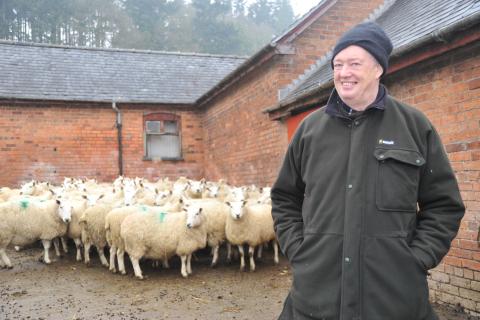13 December 2019
Independent sheep specialist Dr John Vipond says feeding protected forms of soya at 50g/day for every lamb carried and straight soya at 100g/lamb can result in a saving at current prices of more than £3 a ewe.
“High quality silage when supplemented with soya can allow a 75% reduction in concentrate use,’’ Dr Vipond advised farmers during a series of Farming Connect events across Wales.
“Soya is the cheapest and best source of digestible undegraded protein (DUP) in the UK.’’
Dr Vipond urged farmers to rethink their approach to feeding pregnant ewes.
“We have been feeding sheep in the same model as we feed cattle, meeting energy requirements and topping up with protein, but the nutritional needs of modern sheep are very different to the animal that this feeding advice was first based on,’’ he said.
Lamb birthweights have increased and sheep have a higher nutritional requirement.
“We used to get pregnancy toxaemia in hill ewes because they were short of glucose; we are now seeing this in lowland-lambing flocks because we are overfeeding energy and underfeeding protein,’’ said Dr Vipond.
“We are losing too many ewes and lambs directly as a result of feeding them the wrong nutrition.’’
Soya as a livestock feed does raise environmental concerns but if fed in a protected form, the amount can be halved.
“Protected forms are more expensive, but at around twice the amount of bypass protein they work out better,’’ Dr Vipond advised.
But this feeding approach relies on good quality silage.
Dr Vipond recommends allocating ewes ad lib silage and 50g/day/lamb carried of protected soya during the last three weeks of pregnancy - 1.6 % of liveweight should be the maximum silage dry matter intake in late pregnancy.
This can result in a total feed cost of £1.70-£2 instead of feeding 25kg of concentrates at more than £5.
“Farmers worry that sheep don’t have room to digest silage but a ewe has a rumen clearance rate of 8% an hour in late pregnancy instead of the usual 5%,’’ said Dr Vipond.
Soya only need be fed to multiple-bearing ewes; the nutrition in silage is adequate for those carrying single lambs.
As the protein in protected soya is undegraded, it does not need to be fed daily; it can be given every other day at double the daily allocation, said Dr Vipond.
He warned that modern bales are too dense to be fed in ring feeders. “If we are expecting ewes to eat more forage, we must make it easy for them,’’ he said. “Bales should be shaken out or put through a chopper where possible.”
Allow for a minimum of six inches of feeding space per ewe.
One big bale will feed 4-5 ewes. “Identify how many you need now and set these aside for feeding in the final month,’’ said Dr Vipond.
Llifon Davies, Farming Connect’s Red Meat Technical Officer for South West Wales, said condition scoring ewes at this stage of pregnancy is important too.
“Feeding the right nutrition not only makes a big difference to how ewes lamb but to their colostrum quality too. It will also reduce the risk of watery mouth and twin lamb disease.’’
John Vipond’s top tips for meeting the nutritional requirements of pregnant ewes
- Check ewe condition now
- Identify the quality of forage and its availability
- Maximise cheap forage intake
- Identify nutritional deficits in the diet
- Find the best diet solutions
- Feed without causing metabolic upsets or disturbance
Replace concentrates and save money on feed and labour
Farming Connect, which is delivered by Menter a Busnes and Lantra, is funded by the European Agricultural Fund for Rural Development and Welsh Government.

